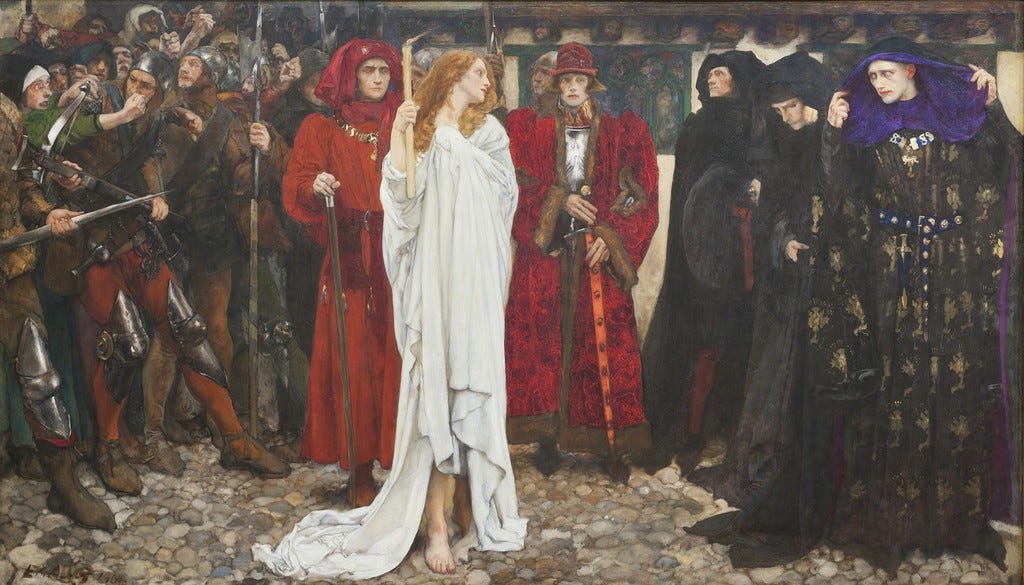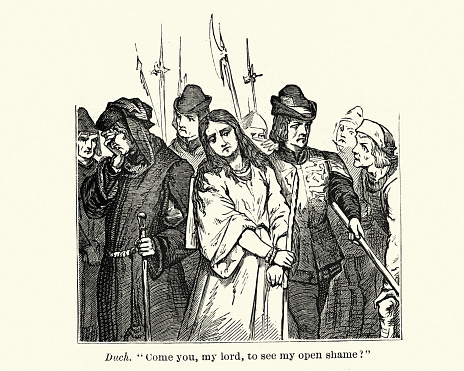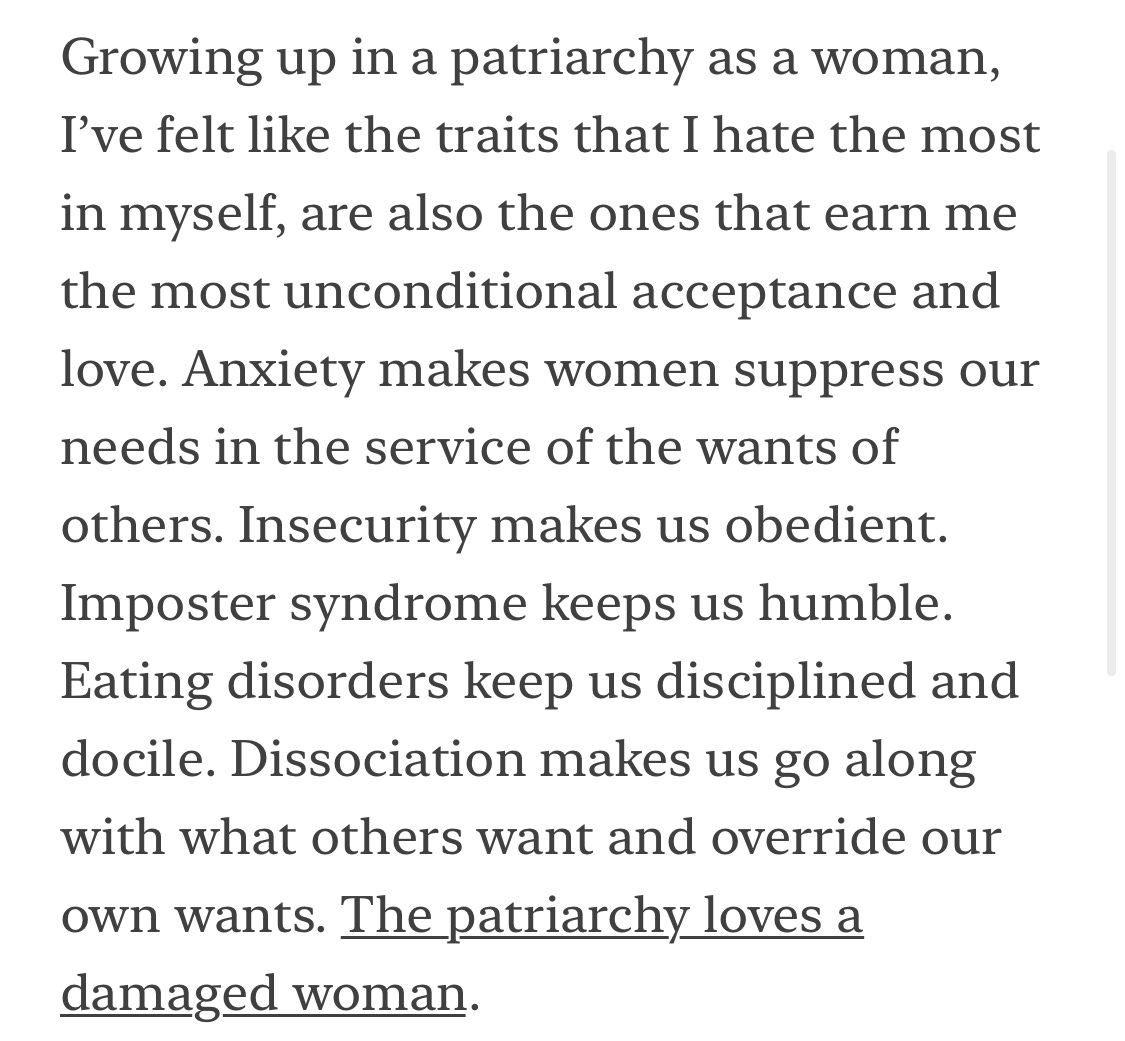Jeremy Clarkson, Meghan Markle, and the rebrand of Medieval misogyny
'Come you, my lord, to see my open shame?'
TW: Sexual assault and abuse
The trend of dismissing harmful rhetoric is all around us, woven into the very fabric of our media sources. The Fox News talking heads carry on as if they have honorary PhD’s in it and even in our most beloved sitcoms it’s ever-present (I’m looking at you, Modern Family.) Heck, in the United States, the last president was caught on tape saying “you know, I’m automatically attracted to beautiful — I just start kissing them. It’s like a magnet. Just kiss. I don’t even wait. And when you’re a star, they let you do it. You can do anything. Grab ’em by the pussy. You can do anything.”
Just so we are clear, that’s sexual assault. Worse yet, it’s bragging about sexual assault as if it’s an achievement. Not waiting for a person to consent to contact is assault. If Donnie was comfortable enough to share that, especially in public, that means he’s confident no consequences will befall him, an indication that the behavior is familiar to him, normal even. Patriarchy sells control, and men are spending every dime of their hard earned integrity on it. For that’s the trade: integrity for control. The price of entry to the patriarchy. “Patriarchy encourages men to surrender their integrity and to live lives of denial. By learning the arts of compartmentalization, dissimulation, and disassociation, men are able to see themselves as acting with integrity in cases where they are not.”1 Cases such as hearing another man bragging about sexual assault and encouraging instead of holding them accountable. Or perhaps the case of laughing along as your friend sexually harasses a woman on the street instead of confronting them. Or what about when your 35-year-old bro starts dating a 19 year old girl? Or the homie that comments on pictures of literal children on social media? I digress.
Jeremy Clarkson, an English talking-head, recently wrote in a British news column: “Meghan [Markle], though, is a different story. I hate her on a cellular level. At night, I’m unable to sleep as I lie there, grinding my teeth and dreaming of the day when she is made to parade naked through the streets of every town in Britain while the crowd chants’ Shame!’ and throw lumps of excrement at her.”
Unable to sleep, dreaming of a woman being physically assaulted and sexually abused. These men need to go to therapy and instead they are creating twitter accounts. The assault of women is so normalized men feel it’s appropriate to dream about it, brag about it, and laud it over their male peers as an example of masculinity. One integrity-ticket, please!
If you somehow avoided Game of Thrones up until this point, then I’ll spare you too many details, but the scene in reference is of a main female character being forced to walk through a crowded medieval town, barefoot in her see-through shift, as penance for nefarious acts. Stripped of dignity, harassed, abused, and dehumanized. This is what Jeremy was fantasizing about, but his subject matter is a very real woman, not a fictional character from his favorite Sunday night drama. The patriarchy allows Jeremy to indulge in rape-culture at his work desk on Friday and is realized in his favorite TV show on Sunday evening. Not to mention, the contradictory nature of calling it "dreaming" whilst also dubbing it a "clumsy reference" is very on-brand for a patriarchal male.
Though Game of Thrones was a dragon-rearing, ice-zombie-having fictional drama, very real women suffer the very real consequences of misogyny every single day. And on November 13th 1441, as Eleanor Cobham walked barefoot down Fleet Street on market day surrounded by peers, taper in hand, with her hair exposed and bare feet pounding against the stone and dirt, I’m certain she understood the ways in which misogyny was dictating and harming her life. Though this modern language informing male behavior didn’t exist in the 15th century, the hatred, contempt, and prejudice towards women was well practiced, documented, and experienced. Women then, as women now, know it well.

Eleanor was born sometime around the year 1400 to a lower nobility family, possibly in Surrey, but due to the fact she is a woman, much isn’t known about her until she is around 22 years of age, when she enters the household of Jacqueline of Hainault as a lady-in-waiting (essentially, a paid companion and confidant to a woman of higher nobility.) Jacqueline, in her own right, was Countess of Hainault, Holland, and Zeeland, but was going through a tumultuous divorce from a man hell-bent on acquiring what was rightfully hers. Jacqueline, after seeking sanctuary within the English royal court, found herself negotiating her next marriage with King Henry V’s brother, Humphrey Duke of Gloucester. This marriage wasn’t to last due to the larger politics of the time, for once Burgundy got involved in Jacqueline’s land dispute, Humphrey was forced to disengage as to not antagonize a key ally in the conquest of French territory. Humphrey’s marriage to Jacqueline was declared null and void, having never received a papal annulment for Jacqueline’s previous marriage.
While Humphrey and Eleanor’s relationship started in 1425, and his annulment from Jacqueline wasn’t declared until 1428, all evidence points to Humphrey and Eleanor having a love match. Humphrey was a Prince of England and Eleanor was a Baron’s daughter, most viewed this pairing as inappropriate for she was an upstart and he was lowering his standards and had abandoned his first wife. Eventually Eleanor and Humphrey were married, and all evidence points to this union being accepted after the initial outrage and distaste. Humphrey’s own stepmother, Dowager Queen of England Joan of Navarre, had gifted Eleanor her personal chapel, ensuring Eleanor wouldn’t face embarrassment due to lacking in her newfound position. The narrative of a prince of England loving a woman deemed unworthy for the position is nothing new.
And similarly to Jeremy Clarkson’s behavior, the misogynistic gossips of the time did all they could to tear apart a woman who dared disrupt the status quo. As Eleanor and Humphrey fell further into love and partnership, building up their influence while investing in pursuits of knowledge, Humphrey’s enemies who sought to control the infant king were plotting their destruction. Humphrey’s position as regent and heir-apparent made him incredibly powerful and he was prolific in flexing that power, however, this wouldn’t do for those who had traded their integrity for greed and control. Humphrey’s position afforded his person a certain level of protection, his vulnerability being in the form of his wife and their shared passion for furthering their knowledge.
It’s important to pause and remember Eleanor in the time she existed, because she does ultimately admit guilt in what comes next. Eleanor lived in a time when inheritance was a driving force in society, when medicine and astrology were intertwined, and religion was integrated into every aspect of life as it offered an explanation to the unexplainable. Life wasn’t compartmentalized as it is now. She also lived in a deeply patriarchal and misogynistic environment. Women’s access to laws of inheritance were more often than not challenged by extended family of the male variety. Women were a means to an end, often treated less than human in even the best of times. Eleanor was also the beloved wife to the heir of the throne of England and the current king was a young child in the time when life expectancy of children wasn’t particularly great. Producing an heir was vital in her position to establish a dynasty and secure her family’s position of power. Eleanor needed to have a son and this just wasn’t happening naturally.
Eleanor and Humphrey’s marital experience was uncommon in that time. They seem to have truly loved each other and enjoyed each other’s company. Humphrey secured positions to ensure her family was cared for and even proactively prepared for Eleanor’s protection and livelihood should he meet an untimely demise. They shared a zest for knowledge and enjoyed hosting their own courtly debates. It seems to have been a true partnership, something that is still unique in 2023. During their time thirsting after knowledge, they had consulted an astrologer and had charts drawn up to help them prepare for their future. To predict their success ultimately meant the demise of the child king, which was treason. Eleanor had also consulted a known herbalist, a woman who lived outside of the societally accepted standard, to help her conceive a child with Humphrey. Reminder: the patriarchy only finds women worthy when they can produce children and Eleanor would have understood her worth was tied to her ability to provide an heir.
Humphrey’s enemies grew in might and took their vengeance on Humphrey via Eleanor. Parading her known peers as necromancers and performatively displaying nefarious tools. Eleanor’s downfall was swift. Even during what would have been a terrifying time, Eleanor acts tenaciously and intelligently. She flees to sanctuary and when the time comes for her to meet her charges, she stands firm in her worth, making it harder to convict her in the crimes that would have ensured Humphrey’s parallel demise. She admits guilt to using a woman convicted of sorcery to help her produce a child, as the evidence against her was astronomical. At the time, witchcraft as a first time offender was more of a warning and dismissal with a promise to never practice again then an immediate march to the stake, but Eleanor needed to be properly disposed as she was just a pawn to the patriarchy. Ultimately, after being made to perform multiple humiliating public penances, she was forced to divorce Humphrey and imprisoned until her eventual death.2
Airplane Mode, by Liz Plank - via SubStack
3 Eleanor, and the multitudes of women throughout history who have been persecuted by the patriarchy deserve for us to acknowledge the forces behind their downfall. It is incredibly harmful when we dismiss the behavior of men in the 15th century with the rhetoric of “that’s just how it was,” because how it “was,” was deeply misogynistic. The misogyny then is simply a stepping stone to the 21st century form of the very same mentality that we are victim of today. So yes, that is just “how it was,” but it was also categorically misogynistic and both can be true at the same time. If we allow the patriarchy to pretend this is a new form of misogyny, then we do our fore-sisters the disservice of not recognizing the true plight they experienced. Today’s misogyny is just a rebrand of medieval misogyny, nothing more.
Eleanor’s experience, or something worse, is the reality if men like Jeremy have their dreams realized. it is 2023, not 1441, yet here we are still dismissing terrifying behavior as a common trait of masculinity. So it feels worth repeating: real women suffer the real consequences of misogyny every single day.
The Will to Change, bell hooks, pg 156. - In my first post I noted I would be referencing this particular work of bell’s often. It is an incredible paradigm-altering read. Understanding the depths of the trauma the patriarchy causes for all of us will allow us to fully embrace our own healing and growth. We cannot heal what we do not know has been harmed.
Royal Witches: From Joan of Navarre to Elizabeth Woodville - By Gemma Hollman is a spectacular and enlightening historical assessment of four women who suffered at the hands of the patriarchy and continued to show up for themselves and other women, against all odds. This was a ‘could-not-put-down; read for me.
I am a huge Liz Plank fan, between her book and her Substack, she is continually teaching me how to show up better for myself and for those around me, particularly the men in my social-orb, because we are all negatively impacted by the patriarchy. Her book For the Love of Men, is a must read and I highly suggest further supporting Liz by subscribing to her Substack.







